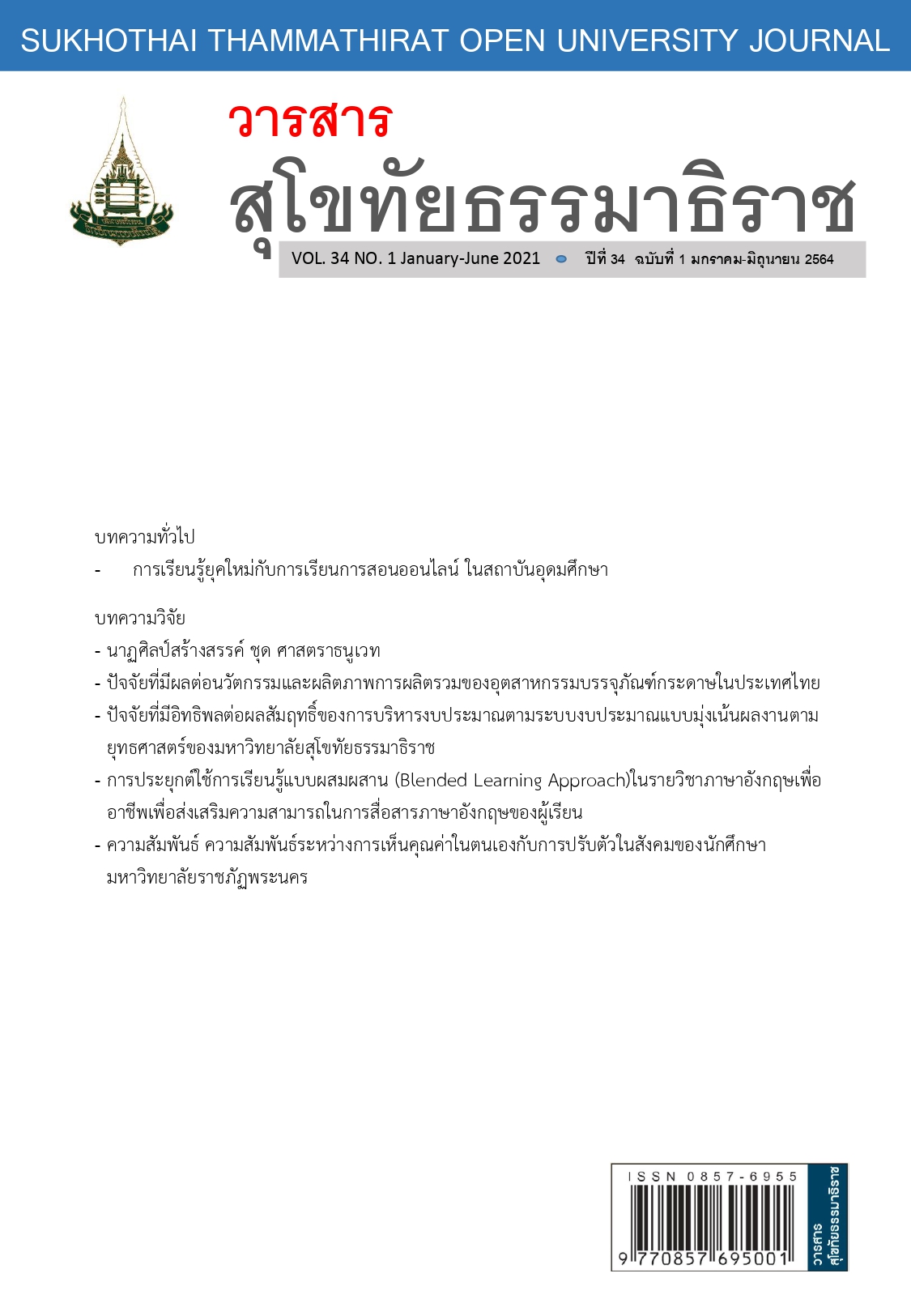การประยุกต์ใช้การเรียนรู้แบบผสมผสาน (Blended Learning Approach)ในรายวิชาภาษาอังกฤษเพื่ออาชีพเพื่อส่งเสริมความสามารถในการสื่อสารภาษาอังกฤษของผู้เรียน
คำสำคัญ:
การเรียนรู้แบบผสมผสาน, ภาษาอังกฤษเพื่ออาชีพ, ความสามารถในการสื่อสารภาษาอังกฤษบทคัดย่อ
การวิจัยในครั้งนี้มีวัตถุประสงค์เพื่อ 1) นำรูปแบบการเรียนรู้แบบผสมผสาน (Blended Learning) มาประยุกต์ใช้ในการพัฒนาหลักสูตรรายวิชาภาษาอังกฤษเพื่ออาชีพ 2) พัฒนาความสามารถและทักษะการสื่อสารภาษาอังกฤษเพื่ออาชีพของผู้เรียน 3) สำรวจความพึงพอใจของผู้เรียนต่อการเรียนด้วยรูปแบบการเรียนรู้แบบผสมผสาน (Blended Learning) กลุ่มตัวอย่างคือนักศึกษาการจัดการอุตสาหกรรม ชั้นปีที่ 2 คณะบริหารธุรกิจ มหาวิทยาลัยเทคโนโลยีราชมงคลรัตนโกสินทร์ วิทยาเขตวังไกลกังวล จำนวน 32 คนได้มาจากการสุ่มแบบเจาะจง (purposive Sampling) ทำการทดลองโดยให้นักศึกษาทำแบบทดสอบก่อนและหลังการเรียนภาษาอังกฤษเพื่ออาชีพจำนวน 10 ครั้งรวม 30 ชั่วโมง
เครื่องมือที่ใช้ในการวิจัยประกอบด้วย 1) หลักสูตรรายวิชาภาษาอังกฤษเพื่ออาชีพ ซึ่งประกอบด้วย แผนการสอน เนื้อหา กิจกรรมและสื่อการเรียนรู้แบบผสมผสาน (Blended Learning)ในการเรียนการสอน 2)แบบทดสอบก่อนและหลังเรียนโดยวัดการใช้ภาษาอังกฤษเพื่อการสื่อสารในงานอาชีพพนักงานประจำสำนักงาน และ 3) แบบสอบถามความพึงพอใจต่อรูปแบบหลักสูตรการเรียนรู้แบบผสมผสาน (Blended Learning) การวิเคราะห์ข้อมูลใช้ t-test และค่าอิทธิพลความต่างของผลคะแนน (effect size) เพื่อเปรียบเทียบความสามารถในการสื่อสารภาษาอังกฤษนักศึกษากลุ่มตัวอย่างทั้งก่อนและหลังเรียน ค่าเฉลี่ยและส่วนเบี่ยงเบนมาตรฐานในการหาค่าระดับความพึงพอใจของนักศึกษาที่มีต่อการเรียนภาษาอังกฤษเพื่ออาชีพด้วยกิจกรรมและสื่อการสอนตามรูปแบบการเรียนรู้แบบผสมผสาน
ผลการวิจัยพบว่า
- ความสามารถในการสื่อสารภาษาอังกฤษของกลุ่มตัวอย่างสูงขึ้นหลังผ่านการ
ฝึกอบรมอย่างมีนัยสำคัญทางสถิติที่ระดับ 0.05 และมีค่าอิทธิพลผลต่างของคะแนนเท่ากับ 5.11
- กลุ่มตัวอย่างมีความคิดเห็นระดับดีต่อรูปแบบหลักสูตรการเรียนรู้แบบผสมผสาน
ที่สร้างขึ้น
References
Allwright, R. (1983). “Language Learning Through Communicative Practice.”Communicative Approach to Language Teaching. Oxford: Oxford UniversityPress.
Brown, H. (2000). Principle of Language Teaching and Learning. 4thEd. New York:AddisonWesley Longman, Inc.
Bitter, S. and Frankl, G. (2012). Evaluation of blended learning courses: The assessment of the e-tutors. Proceeding of International conference on interactive collaboration learning. p.p. 1-6.
Bonk, C. and Graham, C. (2006). The handbook of blended learning environments: Global perspectives, local designs. San Francisco: Jossey‐Bass/Pfeiffer. p.p.5.
Brown, J.D. (1996). Testing in Language Program. New York: Prentice Hall Regents.
Chamberlain, M. and Reynolds. (2007). Blended Learning Initiatives in HigherEducation: Opportunities and Challenges. EdMedia & Innovative Learning 2007. (June 25, 2007) pp. 2397-2402.
Chaima, N. (2012).Development of integrated teaching and learning management model by application of information technology to develop higher thinking skills forstudents of physical educationinstitutions. Phetchabun Campus.Dissertation. Khon Kaen University.
Chanthep, W. & Thammametha, T. (2011).Development of integrated training model with Learning as a team to develop integrated, interdisciplinary teaching design competencies for teachers teach at the elementary school level. Silpakorn Research Journal, V.3, No.1. 2011, p.p. 135-149.
Grave, K. (2000). Designing Language Courses: A Guide for Teacher. Canada: Heinle & Heinle Publishers.
Hughes, G. (2008). Using blended learning to increase learner support and improve retention.London:Institute of Education.
Johnson, Keith.1982.Communication Syllabus Design and Methodology.Pergamon: Oxford.
Khaemmanee, T. (2005).Pedagogy: Knowledge for effective learning process.4thed.Bankok: Publisher of Chulalongkorn University.
Kunarak, K. (2002).Instructional Design.3th ed.Nakhon Pathom: Faculty of Education, Silpakorn University.
Kulthanan, P. et.al.(2011). Blended Learning.www.tci-thaijo.orgcited February 18, 2018.
Lee, S. (2008). Professors’ Perceptions and Needs on Blended e-learning.E-Learn: World Conference on E-learning in Corporate, Government, Healthcare and Higher Education (Oct. 15, 2007) pp. 1113-1126.
Lopez-Perez, M. et. al.(2013). The influence of the use of technology on student outcomes in a blended learning context. Education Technology Research and Development e-Journal.p.p. 625-638.
Mortera-Gutierrez, F. Fostering. (2007). Creativity in a Qualitative Research Course Using Black Board with a Blended Learning Approach: Best Practices. E-Learn: World Conference on E-learning in Corporate, Government, Healthcare and Higher Education (Oct. 15, 2007) pp. 1131-1136.
National Strategy Secretariat Office, National Strategy Plan, Office of the National Economic and Social Development, Bangkok, Thailand, p.23-32, 2018.
Precel, K. et al.(2009). Pedagogical and Design Aspects of a Blended Learning Course. The International Review of Research in Open and Distributed LearningVol. 10 No.2 (Apr. 2, 2009)
Richards, J C.; Rodgers, T S. (2001). Approaches and Methods in Language Teaching.2ndEd. Cambridge, New York: Cambridge University Press.
Savigon, S. (1983). Communicative Competence: Theory and Classroom Practice.Massachusettes: Addison –Wesley Publisher Co.
Sriamdee, P. (2013). The results of blended learning with information technology 2 problem solving activity on problemsolving ability and achievement. Learning of Mathayom Suksa 2 students at Sirindhorn Ratchavayalai School.Veridian E-Journal, V.6, No. 2. 2013, p.p. 582-596.
Tumthong, S. and Wanphirun, P. (2012).Development of a integrated training model using knowledge management techniques to develop competencies according to international professional skill standards.https://journal.oas.psu.ac.th cited. February 18, 2018.
Taba, Hilda. (1962). Curriculum Development: Theory and Practice.New York:Harcourts Brace & World.
Tyler, Ralph W. (1950). Basic Principle of Curriculum and Instruction. Chicago: University of Chicago Press.
Wanphirun, P. (2011).Blended learning from concept to practice.Journal of Vocational and Technical Education.V1. No.2 (Jul.-Dec.2011), p.p 43-49.
Wanphirun, P. and Nilsuk, P. (2013).The results of blended learning using cognitive tools to develop the critical thinking skills of graduate students.https://journal.oas.psu.ac.th. Cited February 18, 2018.
Widdowson, H. and Brumfit, C. (1981). Issues in Second Language Syllabus Design in the Second Language Classroom: Direction for the 1980’s. Oxford: Oxford University Press.
Downloads
เผยแพร่แล้ว
Versions
- 2022-05-02 (3)
- 2022-02-08 (2)
- 2021-09-12 (1)
How to Cite
ฉบับ
บท
License
Copyright (c) 2021 มหาวิทยาลัยสุโขทัยธรรมาธิราช

This work is licensed under a Creative Commons Attribution-NonCommercial-NoDerivatives 4.0 International License.
บทความที่ได้รับการตีพิมพ์เป็นลิขสิทธิ์ของวารสารมหาวิทยาลัยสุโขทัยธรรมาธิราช
ข้อความที่ปรากฏในบทความแต่ละเรื่องในวารสารวิชาการเล่มนี้เป็นความคิดเห็นส่วนตัวของผู้เขียนแต่ละท่านไม่เกี่ยวข้องกับมหาวิทยาลัยสุโขทัยธรรมาธิราช และคณาจารย์ท่านอื่นๆในมหาวิทยาลัยฯ แต่อย่างใด ความรับผิดชอบองค์ประกอบทั้งหมดของบทความแต่ละเรื่องเป็นของผู้เขียนแต่ละท่าน หากมีความผิดพลาดใดๆ ผู้เขียนแต่ละท่านจะรับผิดชอบบทความของตนเองแต่ผู้เดียว
ห้ามนำข้อความทั้งหมด หรือบางส่วนไปพิมพ์ซ้ำ เว้นแต่จะได้รับอนุญาตจากกองบรรณาธิการวารสาร


